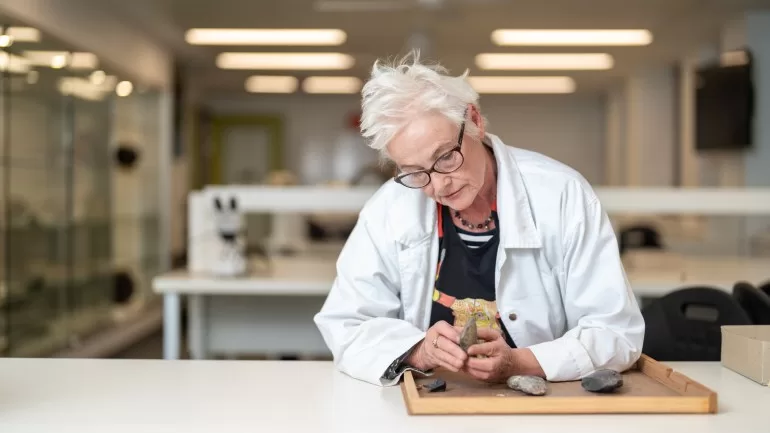Stone artefacts and animal bones found in a deep cave in northern East Timor offer new insights into where ancient humans lived more than 35,000 years before Egyptians built the first pyramids.
Archaeologists from Australian and United Kingdom universities say thousands of stone artefacts and animal bones found in a cave, known as the Laili rock shelter, in the northern parts of East Timor, indicate ancient humans lived there some 44,000 years ago.
The researchers say their analysis of deep sediment, dating back between 59,000 and 54,000 years, from the cave and other locations in East Timor, also known as Timor-Leste, revealed an “arrival signature” that suggests humans were not present in the area before 44,000 years ago.
“Unlike other sites in the region, the Laili rock shelter preserved deep sediments dating between which showed no clear signs of human occupation,” said Shimona Kealy, an archaeologist and palaeobiologist from the Australian National University, who was involved in the research.
Australian National University Distinguished Professor and archaeologist Sue O’Connor said the newly examined sediment gave insights into when humans arrived on the island of Timor.
“The absence of humans on Timor Island earlier than at least 50,000 years ago is significant as it indicates that these early humans arrived on the island later than previously believed,” said O’Connor.
The researchers – from the Australian National University (ANU), Flinders University, University College London (UCL) and the ARC Centre of Excellence for Australian Biodiversity and Heritage – published their findings in the journal Nature Communications this week.
The new discovery in the country is the latest in a region known for some of the most ancient archaeological finds giving insights into the lives of ancient humans, alongside neighbouring Indonesia and Australia.
A region of ancient artefacts
The island of Timor lies to the south of the Indonesian island of Sulawesi, where researchers believe a 45,500-year-old life-size ochre painting of a warty pig could be the oldest rock art painting on earth.
Basran Burhan, an Indonesian archaeologist from southern Sulawesi and current Griffith PhD student who led the survey that found the painting, said of the discovery in 2021 that “humans have hunted Sulawesi warty pigs for tens of thousands of years”.
“These pigs were the most commonly portrayed animal in the ice age rock art of the island, suggesting they have long been valued both as food and a focus of creative thinking and artistic expression,” said Burhan.
The team had earlier found a 44,000-year-old painting in another Sulawesi cave, depicting half-human hunters using what appeared to be spears and ropes to chase wild animals. The discovery of that painting was named one of the top 10 scientific breakthroughs of 2020 by Science magazine.
Ancient cultural heritage at risk?
Many of the oldest cultural heritage sites on earth are found in Australia to the south of East Timor and Indonesia.
Aboriginal people living in Australia have one of the oldest continuous living cultures on earth, as documented by archaeological evidence dating back at least 60,000 years.
At Murujuga in northwestern Australia, an estimated one million petroglyphs include rock carvings dating back as far as 40,000 years.
The carvings include drawings of animals that are now extinct, including nail-tailed wallabies and thylacines, also known as Tasmanian tigers.
The Murujuga Cultural Landscape was formally nominated for UNESCO World Heritage status earlier this year.
“Murujuga is a deeply storied landscape where the ancestors of Ngarda-Ngarli lived and thrived for thousands of generations,” said Murujuga Aboriginal Corporation CEO Kim Wood.
“Every part of this landscape is inscribed with that history, culture and lore that has managed Ngurra [the word for ‘country’ in Indigenous Western desert languages] for 50,000 years,” Wood said.
But some traditional owners have expressed concerns Murujuga could become the latest Indigenous heritage site in Australia to be damaged or destroyed, due to a gas project in the area.
While a UNESCO World Heritage Listing could see the petroglyphs protected, the Western Australia state government last year overturned new cultural heritage laws introduced to protect cultural heritage sites after mining giant Rio Tinto destroyed a 46,000-year-old cultural heritage site at Juukan Gorge, about 1,075km (668 miles) north of Perth.
The destruction of the Juukan Gorge shelters in May 2020 prompted widespread outrage, prompting Rio Tinto’s CEO to resign and an Australian government report titled Never Again, which recommended that the mining giant impose a moratorium on mining in the area and rehabilitate the sacred sites.
